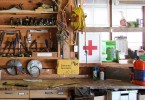Tea brick currency
Tee, thé, cha, tsài, tè, teo, chai, teh, chay—these are all words for the beverage made from leaves of the evergreen shrub Camelia sinensis. Wars have been fought to control its trade and gifts of it have been made to ensure peace. It has even been used as currency. In central and northern Asia, bricks of tea were a unit of value and medium of exchange well into the 20th century.
China had a monopoly on the tea trade right up until the 19th century and, as the taste for tea spread, it became an increasingly valuable commodity. It was exchanged for horses in Mongolia and Tibet. Russian caravans travelled for months across Siberia to trade furs for it.
Tea in the form of bricks was durable, easy to pack and, under the right conditions, could be preserved indefinitely. At factories in China’s Sichuan Province, freshly picked leaves were steamed, pounded into powder and then packed into moulds. The bricks were then dried or baked in the sun to harden.
The characters tell us that the brick was made by the China Tea Industrial Corporation at the Zhao-Li-Qiao Tea Brick Factory in Hubei Province. Tea brick, China, mid 20th century
The value of a brick depended on both the quality of the tea and the distance it had travelled from China. A French missionary travelling in Tibet in the 19th century wrote, “men bargain by stipulating so many bricks or packets (4 bricks) of tea.” Workmen and servants were paid in bricks of tea and a horse cost 20 packets. At the beginning of the 20th century, Western adventurers in remote parts of Mongolia and Tibet found that they couldn’t use gold or silver to buy supplies, but could only use tea.
A very practical money, each tea brick was scored so that sections could be broken off for change, small purchases, or a quick pot of tea. Tea brick, China, mid 20th century
The tea brick shown here was produced in the People’s Republic of China sometime in the mid-20th century. It is in the Bank of Canada Museum’s National Currency Collection and can be seen in Zone 4 of our main gallery along with many curious and fascinating objects that have been used as money.
The Museum Blog
The Adventure of Exhibit Planning VIII
By: Graham Iddon
On this trip, we were all excited to see the 8-foot-tall wooden panels with the full copy printed directly onto them. Using a new process, staff of the exhibition fabrication department at the Sherbrooke Nature and Science Museum have produced some very impressive results.
The Adventure of Exhibit Planning VII
An exhibition fabrication company was finally selected by the Museum to produce the upcoming “Voices from the Engraver” travelling exhibition. It’s all very exciting.
New Acquisitions
By: Raewyn Passmore
The recent additions to the National Currency Collection described below are from very different parts of the world and are between 1500 and 2500 years old.
The Big Nickel
By: Paul S. Berry
The commemorative 1951 5 cent piece was issued to mark the 200th anniversary of the naming of nickel and its isolation as an element. Recently, I had the great pleasure to participate in the Big Nickel anniversary festivities and give a talk about the design competition for the 1951 5 cent coin.
The Adventure of Exhibit Planning VI
By: Graham Iddon
This is not the time for ‘nay sayers’. Basically, we planned a luxury car knowing that when all was said and done, it was going to be a very nice family sedan (maybe with the big engine?).
The Adventure of Exhibit Planning V
By: Graham Iddon
Now the writer takes a deep breath and attempts to take a subject like the ‘representation of 75 years of national identity as depicted on stamps and bank notes’ from 50 pages of research and squash it into 65 words.
The Senior Deputy Governor’s Signature
By: Graham Iddon
For much of their history, Canadian bank notes have represented a promise, a guarantee that they could be redeemed for “specie” (gold and silver coins) at their parent institution.
Becoming a Collector V
By: Graham Iddon
Suppose you walk into a bar frequented by currency collectors and in an attempt to join in you refer to a ‘planchette’ as a ‘rosette’ (beer mugs hit the tables and the pianist stops playing). This could be pretty humiliating and you’ll probably never be able to go to that bar again, at least not on numismatic night.
Becoming a Collector IV
By: Graham Iddon
Now that you have a grasp of preservation techniques for coins, you might want to familiarize yourself with the finer points of their anatomy. It is all part of your numismatic education and besides, you need to be informed and sound informed when you are buying coins at flea markets or coin fairs.









